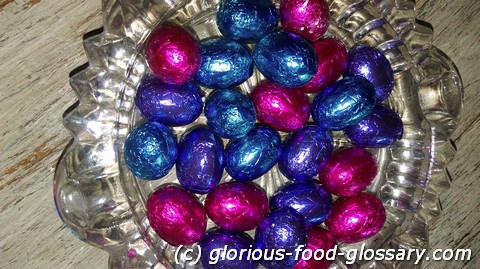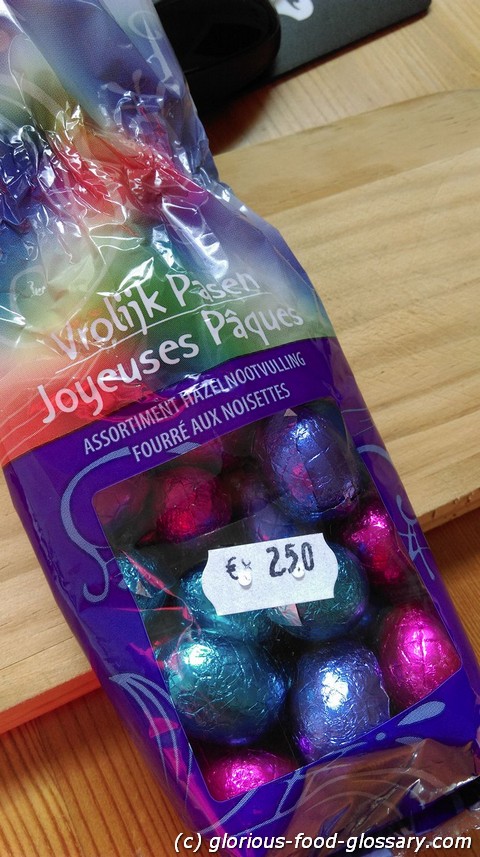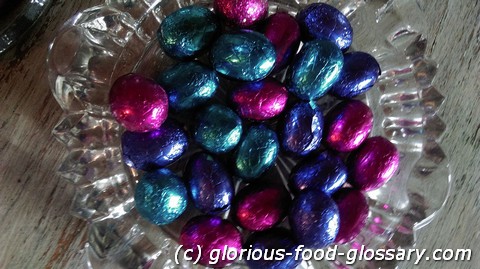Deutsch: Osterei / Español: Huevo de Pascua / Português: Ovo da Páscoa / French: Å’uf de Pâques / Italiano: Uovo di Pasqua /
Easter Egg in the food context refers to a delightful and often decorative treat associated with the Easter holiday. These eggs are typically made from chocolate or sugar and are designed to resemble real eggs. Easter Eggs are a cherished tradition in many cultures, where they symbolize rebirth and new beginnings. They come in various sizes, colors, and designs, making them a popular treat during the Easter season.
Application Areas of Easter Eggs:
-
Easter Celebrations: Easter Eggs are an integral part of Easter celebrations worldwide. They are used as decorations, hidden for egg hunts, and exchanged as gifts among friends and family.
-
Confectionery: Chocolatiers and confectionery shops create a wide variety of Easter Eggs, ranging from small, foil-wrapped eggs to large, intricately decorated ones. These confections are sold to customers looking to celebrate the holiday in a sweet way.
-
Home Baking: Many people enjoy making their Easter Eggs at home. This DIY approach allows for creativity in decorating and filling the eggs with candies, toys, or other surprises.
-
Easter Egg Hunts: In various countries, children participate in Easter Egg hunts, where they search for hidden eggs, often filled with chocolates or small gifts. These events are organized in gardens, parks, and even indoors.

Well-Known Examples of Easter Eggs:
-
Cadbury Creme Eggs: Cadbury's Creme Eggs are a popular Easter treat known for their creamy filling encased in a chocolate shell. They are widely available during the Easter season.
-
Chocolate Easter Bunny Eggs: These eggs are molded to resemble chocolate bunnies and often contain additional chocolates or candies inside.
-
Colorful Sugar Eggs: Sugar eggs, made from a mixture of sugar and water, are elaborately decorated with icing and miniature scenes inside. They are both decorative and edible.
-
Plastic Fillable Easter Eggs: These are plastic egg-shaped containers that can be filled with small toys, candies, or coins. They are commonly used in Easter egg hunts.
Risks Associated with Easter Eggs:
-
Allergies: Many Easter Eggs contain common allergens like nuts, milk, and soy. People with food allergies should be cautious when consuming or handling Easter Eggs.
-
Choking Hazard: Small toys or candies placed inside Easter Eggs can pose a choking hazard to young children. Adult supervision is essential during Easter egg hunts.
Popular Easter Egg Recipe - Chocolate Easter Eggs:
- 12 ounces of high-quality milk or dark chocolate
- Easter egg molds
- Food-safe paintbrushes
- Edible food coloring
- Small candies, mini marshmallows, or other fillings (optional)
- Melt the chocolate using a microwave or a double boiler until it is smooth and completely melted.
- Use a food-safe paintbrush to coat the inside of the egg molds with a thin layer of melted chocolate. Ensure even coverage and let it set in the refrigerator for about 10 minutes.
- Repeat the coating process 2-3 times, allowing each layer to set in the refrigerator. This builds a sturdy shell for your Easter Eggs.
- Once the shell is firm, carefully remove it from the molds.
- If desired, fill each half of the shell with small candies, mini marshmallows, or any other treats.
- Gently warm the edges of the filled shells and press them together to seal the Easter Eggs.
- Allow the eggs to cool and harden in the refrigerator.
- Once set, you can decorate your Easter Eggs with edible food coloring and additional chocolate drizzles.
History and Legal Basics:
The tradition of Easter Eggs dates back centuries, with eggs symbolizing fertility and rebirth in many cultures. Early Christians adapted this tradition to represent the resurrection of Jesus Christ. The commercial production and sale of Easter Eggs are subject to food safety regulations in most countries.
Examples of Sentences:
- She decorated the Easter Egg with intricate patterns and vibrant colors.
- The children had a fantastic time searching for Easter Eggs in the garden.
- We're planning to give out chocolate Easter Eggs to our neighbors this year.
Similar Things or Synonyms:
- Easter chocolates
- Egg-shaped confections
- Holiday treats
Weblinks
- information-lexikon.de: 'Osterei' in the information-lexikon.de (German)
Summary
Easter Eggs in the food context are sweet treats made from chocolate or sugar, popularly enjoyed during the Easter holiday. They serve as decorative items, gifts, and the centerpiece of Easter egg hunts. Whether homemade or store-bought, these delightful creations add a touch of sweetness to Easter celebrations, embodying the spirit of renewal and joy associated with the holiday.


Related Articles to the term 'Easter Egg' | |
| 'Cookie' | ■■■■■■■■ |
| Cookie in the food context refers to a small, sweet, baked treat that is popular in many cultures around . . . Read More | |
| 'Cupcakes' | ■■■■■■■ |
| Cupcakes in the food context refer to small, individual-sized cakes that are baked in a cup-shaped foil . . . Read More | |
| 'Corsage' at fashion-glossary.com | ■■■■■■■ |
| Corsage in the fashion context refers to a small bouquet of flowers worn on the body, typically pinned . . . Read More | |
| 'Fish' at travel-glossary.com | ■■■■■■ |
| In the travel context, having fish as part of breakfast can be seen as a reflection of regional culinary . . . Read More | |
| 'Realm' at travel-glossary.com | ■■■■■■ |
| Realm: In the travel context, realm often refers to a specific area or domain characterized by its unique . . . Read More | |
| 'Pasalubong' | ■■■■■■ |
| Pasalubong refers to a Filipino tradition involving the giving of gifts or souvenirs, often food items, . . . Read More | |
| 'Erdbeer Creme Torte' | ■■■■■■ |
| Erdbeer Creme Torte, in the food context, refers to a Strawberry Cream Cake, a delightful dessert that . . . Read More | |
| 'Cotton Candy' | ■■■■■■ |
| Cotton Candy in the food context refers to a form of spun sugar. It is a popular confection that resembles . . . Read More | |
| 'Confectionery' | ■■■■■■ |
| Confectionery refers to a broad category of sweet foods and desserts, typically made from sugar and other . . . Read More | |
| 'Impeke' | ■■■■■■ |
| Impeke refers to a popular Burundii, a country located in East Africa, home-brewed beer made from sorghum. . . . Read More | |
